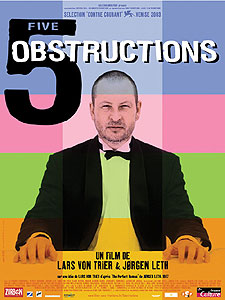Film Reviews
 The Five Obstructions (2004)—Danish
The Five Obstructions (2004)—Danish
In 1967 the Danish director Jorgen Leth made a 12-minute film called The Perfect Human (be sure to get the DVD that includes this as an extra, and watch it first). In this documentary the controversial director Lars von Trier challenges his mentor to remake the film, which captivated him so much that he viewed it twenty times, but to do so following five different "obstructions" that he stipulates. First, he must film in Cuba with no set and no shot longer than 12 frames (about half a second). Next, he must go to wherever Leth feels is "the most miserable place on earth" and remake the film with himself playing the lead role, and so that it does not reveal the location. Third, Leth is given complete freedom to do as he pleases. Next, he must remake the film as an animated cartoon, since that is a medium both of them despise. Finally, in the most poignant part of the film, Leth must simply narrate a script written by von Trier, that is, the master must relinquish all control to his imperious student.
At one level this film is a fascinating look inside the aesthetic process, and how ostensible limitations can provoke rather than diminish creativity, for Leth does not, in fact, produce what von Trier predicts will be "a piece of crap" that "ruins a little gem." I was reminded, for example, of the strictures imposed by, say, eighteenth century musical style, which music is immediately recognizable because of that style, and yet on the other hand the limitless creativity that Mozart used to explore and expand the genre. At a second level, the film explores the ethics of the relationship between the subjective film maker and both his local context and the "objects" he films (often people, of course). Can Leth really make a film in the red light district of Bombay without being impacted by that context, or by ignoring it altogether? Would it be false to try such? Does he not have any personal qualms about filming a sumptuous dinner amidst starving masses? Third, we have here a contest between two different film styles, in which the iconoclastic von Trier tries to demolish the classical style of his teacher. Finally, von Trier admits that he is trying to "banalize" Leth, to force him to make a film that "marks" him or gets under his skin so that he cannot hide his true self behind the safety of the camera. He wants Leth to squirm like a turtle wriggling on its back. That is, he wants to prove that his mentor and idol is not "the perfect human." Leth intimates that von Trier fails, because he does in fact realize that he is merely an "abject, human human." Rather than reveal something about Leth, von Trier reveals that it is he who is the ultimate "obstruction" when he projects onto Leth something that is not there. In Danish with English subtitles.
Dan Clendenin: dan@journeywithjesus.net


